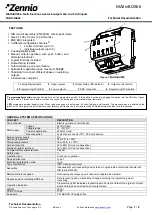
UG-1828
Preliminary Technical Data
Rev. PrC | Page 186 of 338
The Rx programmable FIR can be loaded a customized lowpass filter profile to stop the adjacent channel interference, which is helpful to
achieve better channel selectivity. For example: as shown in Figure 171, before the CFO is corrected, the BBIC may program a loose filter
profile onto the Rx Programmable FIR to perform common filtering. However, after the CFO is corrected via Carrier Frequency
Corrector block, a tight filter profile can be loaded to perform the deep channel selection filtering. The change in the filter profile can be
initiated by the BBIC on demand in the RF_Enabled State.
Figure 171. Loose Filter Profile vs. Tight Filter Profile
Frequency Discriminator
Frequency Discriminator in rxnbdem is to translate the IQ signal into Frequency Deviation (FD) signal, performing the frequency
demodulation in the digital domain. This module can be bypassed.
Figure 172. Functional Diagram of Frequency Discriminator
Illustrated by Figure 172, the Frequency Discriminator outputs the transient frequency deviation (FD) and the transient squared
magnitude (Mag2) sample by sample. The output FD and the output Mag2 are defined as the following:
where
𝑎𝑎𝑎𝑎𝑎𝑎𝑎𝑎
2
is same as the function in Octave, and
D
is the programmable delay. Typically,
D
is chosen as ‘1’, which means 1 sampling
clock delay.
Assuming the input IQ signal is the complex single tone, given by
where
A
is the signal magnitude,
f
t
is the tone frequency,
f
S
is the sampling frequency. The output of the frequency discriminator (FD) is D
× 2f
t
/f
S
while the output Mag2 is A
2
.
NB Programmable FIR
NB Programmable FIR in rxnbdem is to perform the pulse shaping filtering or the low pass filtering at the output of the Frequency
Discriminator. This module can be bypassed.
CFO
THE WANTED CHANNEL
BEFORE
CFOIS CORRECTED.
THE WANTED CHANNEL
AFTER
CFO IS CORRECTED.
DC
DC
LOOSE FILTER PROFILE
TIGHT FILTER PROFILE
24159-
129
D
D
I
Q
–
ATAN2
FREQUENCY
DEVIATION
(FD)
SQUARED
MAGNITUDE
(Mag2)
X
Y
24159-
130
















































